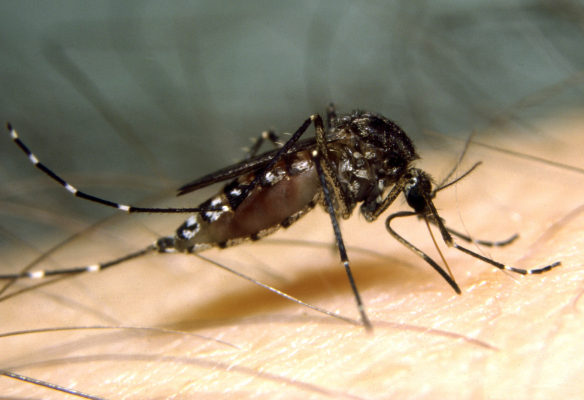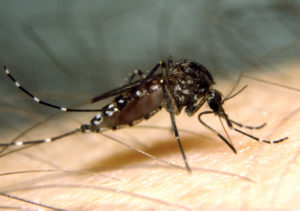

Salt-marsh Mosquito Aedes vigilax (Photo: Stephen Doggett)
Mosquitoes have long been known to infest the coastal area of southern Redlands.
At present this area is not heavily populated so the risk of people contracting mosquito borne diseases is relatively low. This could change if plans for a major residential development are approved.
Public health implications of locating people close to mosquito breeding areas should be carefully assessed together with likely community costs.
Are mosquitoes a health risk?
Residents of the proposed Shoreline development at Redland Bay would be living close to major mosquito breeding habitats and so will be at greater risk of being bitten by mosquitoes than people living further away.
Medical entomologist Darryl McGinn prepared a Biting Insect Management Strategy report for the Shoreline proponents. This report advises that specific information about the distribution and abundance of biting mosquitoes during periods of peak seasonal activity is needed to enable development of a detailed management plan to minimise the risks to residents and visitors.
In its conclusion the McGinn report states:
The Shoreline Redlands development presents some challenges as it is exposed to mosquitoes and biting midges associated with salt-marsh and intertidal habitats of Redland Bay. Because of its current low residential population, the development site and adjoining area are not currently subject to high resolution adult biting insect surveillance by Council. There is currently a lack of good quality entomological data upon which to fully characterise the public health and nuisance biting risks or to objectively inform an appropriate management response. Notwithstanding that more scientific detail is required; there is ample anecdotal evidence of the biting insect problem in the southern Redland Bay.
Where are the mosquitoes found?
The McGinn report notes that the salt-marsh mosquito Aedes vigilax is known to breed in a number of areas on the Shoreline development site as well as nearby Pannikan, Long and Lagoon islands. The Report states that “This species has a known pest range of several kilometres from major breeding sites.”
The report also notes that the proposed development site currently contains suitable habitat for at least five mosquito species that breed in freshwater.
The distribution and abundance of mosquitoes during periods of peak seasonal activity is not well known because that information has not been collected. The McGinn Strategy report notes that among other things, Shoreline would be responsible for: “An entomological field survey to characterise the diversity and seasonal abundance of biting insects”.
Mosquitoe borne diseases in south east Queensland
Brisbane City Council advises that Ross River Virus and Barmah Forest Virus are the two most common diseases transmitted by mosquitoes to humans in south east Queensland. Dogs can also be at risk of contracting heartworm via mosquitoes. Ross River Virus causes skin rashes, joint pain, fatigue and fever. It can persist for an extended period of time and is a wholly unpleasant experience. These diseases are carried by both salt-marsh and freshwater breeding mosquitoes.
The frequency of mosquito borne diseases has increased over the past year in South East Queensland. For example, the number of Ross River Virus infections has increased from 120 in 2014 to over 380 in 2015. There is a strong trend for the increasing frequency of infection by Ross River Virus in South East Queensland.
In the past year most of these incidents occurred in Brisbane metropolitan area (150 cases) and Gold Coast (77 cases). As more people move closer to mosquito breeding areas, it can be expected that the infection rates will increase unless effective steps are taken to reduce human exposure to biting mosquitoes.
Is DEET mosquito repellent safe for humans?
Generally, people need to modify their behaviour and clothing to reduce their exposure to biting insects. In addition the Queensland Department of Health recommends that the use of mosquito repellent containing DEET (chemical name, N,N-diethyl-meta-toluamide).
There are some concerns about the adverse effects of DEET on humans and people have been advised to minimise exposure to DEET.
It has been reported in the United States that DEET may cause severe skin irritation and in rare cases it has caused seizures in people, resulting in the death of a few. In another study, it was reported that National Park workers exposed to DEET were more likely to suffer from mood swings, insomnia and impaired cognitive function than co-workers not exposed to DEET. However, the American Environmental Protection Agency considers that the risk of using DEET 10-30% active ingredient is small compared the harm due to the diseases DEET is preventing.
Cost implications for the community

Redland City Council’s Mosquito Control Operations site in southern Redlands
Development of a major residential development next to a mosquito breeding ground would increase the amount of spraying work that Redland City Council would have to undertake. This is acknowledged in the McGinn report which states: “The future residents and visitors of Shoreline Redlands will be dependent on Council’s management of mosquitoes in areas it controls.”
Who would be responsible for the other potential costs that might result if people residing or visiting this area were to contract any of the diseases transmitted by mosquitoes?
Any community costs resulting from location of a major residential development next to a major mosquito breeding ground should be fully considered by the Council as part of a comprehensive assessment process.
There has to be a better way!
The Redlands City mosquito fact sheet admits that Council’s control program will not kill all adult mosquitoes. Even with a control program, there is still a risk of people contracting mosquito borne diseases. As development encroaches on mosquito breeding areas, exposure of people to mosquito borne diseases will increase.
Council’s land supply study report found that Redland City has enough land already approved for residential development to meet likely needs for the next 25 years.
So why would Council seriously consider approving a major new residential development next to a major mosquito breeding area?
The Council is supposed to make decisions in the public interest. Increasing the risk of people contracting diseases from mosquitoes does not seem to be in the public interest.
Redlands2030 – 21 August 2015
Please note: Offensive or off-topic comments will be deleted. If offended by any published comment please email thereporter@redlands2030.net
5 Comments
I read the article on Mosquitos and being a retired solicitor my lawyer’s brain raised one word. Liability. If with knowledge of the risk. awareness of the consequences, and I think the short article at least raises the issue of series health risks, the Council endorses and approves the development then I would suggest in the interest of ratepayers ultimately footing the bill for compensation, economic loss and loss in property values just to start with, that Council get good legal advice.
I have caught both Barmah Forest and Ross River viruses and can assure you they a particularly debilitating.
Chris Ayres MA MEd(Hons) LLB LLM(Tax) Grad Dip Leg Prac Solicitor High Court of Australia, Supreme Courts NSW and Qld.
57 Hilliards Park Drive
Wellington Point Qld 4160
Chris wow your comments of compensation for bad decisions is an interesting concept, wonder if elected members and council officers who write these approvals feel about the issue of legal action
Yes Mosquitos are a problem, but one that can be minimized with a bit of common sense and planning. The Morton Bay Islands are a haven for them and due to councils lack of planning and due diligence a greater problem than nessessary. The island has roads that need to be treated with the same respect as the mainland, for example.. Proper gutters, proper drainage instead the roads are gravel with ditches that in a lot of areas are continually sodden due to the run off of water. Park and swamp areas not kept clean, they are left overgrown and not managed. Blocks of land not developed due to council continually letting down residents with the promise of a bridge and infrastructure. Council needs to do now what is needed on these islands, or the land shouldn’t have been subdivided and rates should have never been collected, promises should have never been made.. It is too late now so Council has an obligation and duty of care to move forward with these islands. On the positive side for the council, look how much money and respect this council would get given the right decisions.
The Southern Moreton Bay Islands have been subdivided for residential development in the 1970 – ties for an ultimate population of 22500 people without even applying the most basic town planning rules and requirements .
Nobody gave a damn about mosquitoes and midges then.
But that are not the problems, the SMBI islands are facing. Mosquitoes are manageable. What is much more important is the lack of proper Transport and Infrastructure on the Islands. Before a subdivison like Shoreline is approved, the Government and RCC should look at open up the already subdivided land on the islands. There are almost 6000 to 8000 blocks available. What’s needed is a road/ bridge connection to the mainland.
When are our authorities and politicians finally waking up?
During the drafting of the 1998 and 2006 PLanning scheme debate between Environmental health officers and Councillors regarding mosquito breeding areas was ongoing. In 1998 large areas of Redland Bay (Collins, School of Arts Road etc ) and Thornlands (South and Thornlands Road) ere opened up for residential development , and in 2006 South East Thornlands approved for development, areas close to the coast and major Mangrove areas. These approvals were identified that residents would be impacted due to biting midge and mossies Council has been proactive in funding a mosquito breeding program, even inventing a runnelling machine, but these initiates still are only a minimal change in the mosquito breeding and biting midge, the breeze also brings mossies from islands and sand banks in the bay. Is it acceptable that developers open large parcels of land and bring 10.000 people into this area and then the ratepayers have to fund major mossie and sand fly control to allow these residents to have a safe and enjoyable lifestyle outdoors?